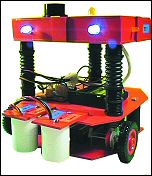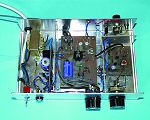
![]() Thunderstorm Monitor - helps warn of imminent lightning strikes. This fascinating and thoroughly presented constructional article describes the principles of detecting lightning, with test measurements and observations made during prototyping. The Monitor is an op.amp circuit coupled to a special "antenna" and optional moving coil meter display.
Thunderstorm Monitor - helps warn of imminent lightning strikes. This fascinating and thoroughly presented constructional article describes the principles of detecting lightning, with test measurements and observations made during prototyping. The Monitor is an op.amp circuit coupled to a special "antenna" and optional moving coil meter display.
![]()

![]() Logic Probe - A handy test item for tri-state monitoring of logic circuits. Powered from the circuit under test, this design uses a bi colour LED and can be used on a wide range of TTL and CMOS devices. An ideal complement to the author's Volt Checker described in the October 2004 issue.
Logic Probe - A handy test item for tri-state monitoring of logic circuits. Powered from the circuit under test, this design uses a bi colour LED and can be used on a wide range of TTL and CMOS devices. An ideal complement to the author's Volt Checker described in the October 2004 issue.
![]()


![]() M.W. Amplitude Monitor - Enjoy your listening as you used to, through your radio of bygone eras. It is becoming an increasingly popular pastime to renovate old radios (as readers of our sister magazine Radio Bygones will agree!) but these units are usually Medium and Longwave Wave A.M. only. A great deal of present-day radio transmissions are unavailable to these old radio receivers. Our MW Amplitude modulator takes its input from a present day DAB or FM receiver (for example) and regenerates it into an a.m.-modulated format on the MW band for feeding into the aerial input of your old radio.
M.W. Amplitude Monitor - Enjoy your listening as you used to, through your radio of bygone eras. It is becoming an increasingly popular pastime to renovate old radios (as readers of our sister magazine Radio Bygones will agree!) but these units are usually Medium and Longwave Wave A.M. only. A great deal of present-day radio transmissions are unavailable to these old radio receivers. Our MW Amplitude modulator takes its input from a present day DAB or FM receiver (for example) and regenerates it into an a.m.-modulated format on the MW band for feeding into the aerial input of your old radio.
![]() EPE February 2005 P.136 we said that inductor L1 may be hard to find but the EZ45336 from JAB Components can be used instead. C4 must then be changed to 220pF.
EPE February 2005 P.136 we said that inductor L1 may be hard to find but the EZ45336 from JAB Components can be used instead. C4 must then be changed to 220pF.

![]() M.W. Amplitude Monitor interior view.
M.W. Amplitude Monitor interior view.
Also in this issue:
- Practical Electronics' (PE) 40th Anniversary - how it all started in 1964. Feature.
- Light Emitting Diodes - 3. Boosters, alternative Flashers and Multicolour LEDs. Includes a single cell 1.5V LED flasher.
- Circuit Surgery on current flow and Zener diode operation
- Techno Talk outlines digital techniques for reviving historic sound recordings
- Floating Point Maths for PICs.
- Net Work - the internet page on legal and commercial issues surrounding domain names.
All this and more in the Number One hobby electronics magazine! Subscribe now or visit our Online Shop.